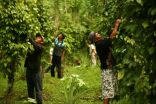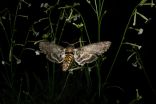In a paper published today in The Optical Society's new, high-impact journal Optica, a research team from the University of Stuttgart, Germany and the University of Eastern Finland, Joensuu, Finland, has harnessed the human eye's color-sensing strengths to give the eye the ability to distinguish between objects that differ in thickness by no more than a few nanometers -- about the thickness of a cell membrane or an individual virus.
This ability to go beyond the diffraction limit of the human eye was demonstrated by teaching a small group of volunteers to identify the remarkably subtle color differences in light that has passed through thin films of titanium dioxide under highly controlled and precise lighting conditions. The result was a remarkably consistent series of tests that revealed a hitherto untapped potential, one that rivals sophisticated optics tools that can measure such minute thicknesses, such as ellipsometry.
"We were able to demonstrate that the unaided human eye is able to determine the thickness of a thin film -- materials only a few nanometers thick -- by simply observing the color it presents under specific lighting conditions," said Sandy Peterhänsel, University of Stuttgart, Germany and principal author on the paper. The actual testing was conducted at the University of Eastern Finland.
The Color and Thickness of Thin Films Thin films are essential for a variety of commercial and manufacturing applications, including anti-reflective coatings on solar panels. These films can be as small as a few to tens of nanometers thick. The thin films used in this experiment were created by applying layer after layer of single atoms on a surface. Though highly accurate, this is a time-consuming procedure and other techniques like vapor deposition are used in industry.
The optical properties of thin films mean that when light interacts with their surfaces it produces a wide range of colors. This is the same phenomenon that produces scintillating colors in soap bubble and oil films on water.
The specific colors produced by this process depend strongly on the composition of the material, its thickness, and the properties of the incoming light. This high sensitivity to both the material and thickness has sometimes been used by skilled engineers to quickly estimate the thickness of films down to a level of approximately 10-20 nanometers.
This observation inspired the research team to test the limits of human vision to see how small of a variation could be detected under ideal conditions.
"Although the spatial resolving power of the human eye is orders of magnitude too weak to directly characterize film thicknesses, the interference colors are well known to be very sensitive to variations in the film," said Peterhänsel.
Experimental Setup The setup for this experiment was remarkably simple. A series of thin films of titanium dioxide were manufactured one layer at a time by atomic deposition. While time consuming, this method enabled the researchers to carefully control the thickness of the samples to test the limitations of how small a variation the research subjects could identify.
The samples were then placed on a LCD monitor that was set to display a pure white color, with the exception of a colored reference area that could be calibrated to match the apparent surface colors of the thin films with various thicknesses.
The color of the reference field was then changed by the test subject until it perfectly matched the reference sample: correctly identifying the color meant they also correctly determined its thickness. This could be done in as little as two minutes, and for some samples and test subjects their estimated thickness differed only by one-to-three nanometers from the actual value measured by conventional means. This level of precision is far beyond normal human vision.
Compared to traditional automated methods of determining the thickness of a thin film, which can take five to ten minutes per sample using some techniques, the human eye performance compared very favorably.
Since human eyes tire very easily, this process is unlikely to replace automated methods. It can, however, serve as a quick check by an experienced technician. "The intention of our study never was solely to compare the human color vision to much more sophisticated methods," noted Peterhänsel. "Finding out how precise this approach can be was the main motivation for our work."
The researchers speculate that it may be possible to detect even finer variations if other control factors are put in place. "People often underestimate human senses and their value in engineering and science. This experiment demonstrates that our natural born vision can achieve exceptional tasks that we normally would only assign to expensive and sophisticated machinery," concludes Peterhänsel.
INFORMATION:
Paper: S. Peterhansel, H. Laamanen, J. Lehtolahti, M. Kuittinen, W. Osten, J. Tervo, "Human color vision provides nanoscale accuracy in thin-film thickness characterization," Optica, 2, 7, 627 (2015).
doi: 10.1364/OPTICA.2.000627
About Optica
Optica is an open-access, online-only journal dedicated to the rapid dissemination of high-impact peer-reviewed research across the entire spectrum of optics and photonics. Published monthly by The Optical Society (OSA), Optica provides a forum for pioneering research to be swiftly accessed by the international community, whether that research is theoretical or experimental, fundamental or applied. Optica maintains a distinguished editorial board of more than 20 associate editors from around the world and is overseen by Editor-in-Chief Alex Gaeta of Cornell University. For more information, visit http://optica.osa.org.
About The Optical Society
Founded in 1916, The Optical Society (OSA) is the leading professional organization for scientists, engineers, students and entrepreneurs who fuel discoveries, shape real-life applications and accelerate achievements in the science of light. Through world-renowned publications, meetings and membership initiatives, OSA provides quality research, inspired interactions and dedicated resources for its extensive global network of optics and photonics experts. OSA is a founding partner of the National Photonics Initiative and the 2015 International Year of Light. For more information, visit http://www.osa.org.






